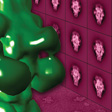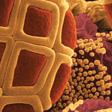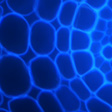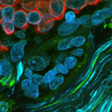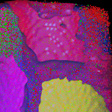 The green blob is a protein produced by a bacterium. Because it is toxic to some insect pests it has potential as a bioinsecticide, to protect food crops. The 'wallpaper' shows steps in the 3-D reconstruction of the protein's structure from the transmission electron microscope images on the 'carpet'.
The green blob is a protein produced by a bacterium. Because it is toxic to some insect pests it has potential as a bioinsecticide, to protect food crops. The 'wallpaper' shows steps in the 3-D reconstruction of the protein's structure from the transmission electron microscope images on the 'carpet'.
Visualised using single particle analysis by Dr Michael Landsberg, University of Queensland.
Size: the protein is about 30 nanometres high.
Working out the structure of different proteins is really helpful to scientists in understanding exactly how they function. Understanding how this protein works will be useful in developing it as an effective pesticide. The control of harmful insects is incredibly important in agriculture. Insecticides of biological origin are thought to be more environmentally friendly and safer to humans, wildlife and beneficial insects. This protein is toxic to several insect pests including a species of moth, which has spread worldwide and infests some types of vegetable crops such as cabbages, broccoli, Brussels sprouts, cauliflowers, radishes, turnips & mustard seed. It is always important to develop new pesticides as pests can gradually become resistant to pesticides that are used for a long time.




